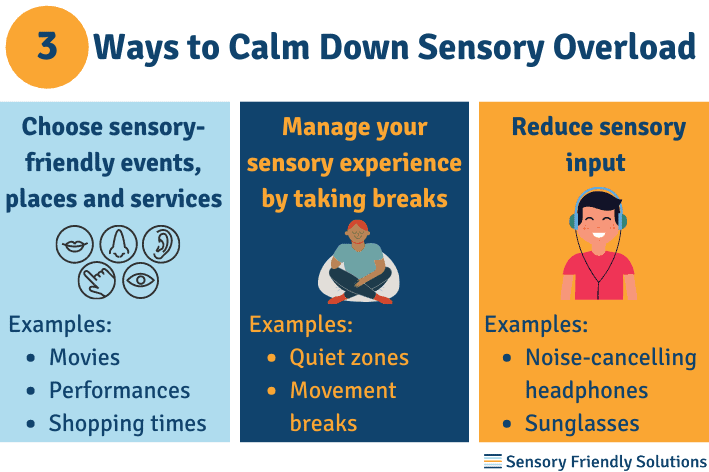Table of Contents
What Is Sensory Overload and Why Does It Happen?
Have you ever walked into a bustling restaurant where the clatter of dishes, overlapping conversations, and flashing lights instantly made you want to retreat? Or been in a grocery store where bright overhead lights, colorful displays, and constant motion left you tense and disoriented? Importantly, these moments of overwhelm are not rare—and may be signs of sensory overload.
For instance, imagine a child at a birthday party who suddenly becomes quiet and withdrawn because the music is too loud, the room is too crowded, and the activity is too chaotic. Or, as another example, think of an office worker who finds it nearly impossible to concentrate by mid-day due to constant background chatter, phones ringing, and bright lights.
These are real-world examples of how everyday environments can push our senses past their limit.
In this post, we’ll explore what sensory overload looks like, why it happens, who it affects, and most importantly—how to manage it.
Common Symptoms
Sensory overload happens when your brain struggles to process too much sensory input at once. Common symptoms include:
Withdrawal – Many people need to retreat to a quiet, low-stimulus space
Irritability – Bright lights or sudden sounds may feel unbearable
Difficulty focusing – You may feel scattered or distracted
Anxiety or panic – Sensory overload can heighten emotional responses
Physical discomfort – Headaches, nausea, or dizziness can result
How Sensory Overload Affects Adults
Sensory overload isn’t just a childhood concern—it affects adults, too, often in environments like:
- Open-concept offices
- Crowded shopping malls
- Busy public transit
- Bright or noisy restaurants
Moreover, when left unrecognized, sensory overload can lead to burnout, fatigue, anxiety, and difficulty managing daily tasks.
Furthermore, adults often push through without realizing what’s wrong. However, recognizing sensory overload is a powerful first step toward reducing stress and protecting your mental health.

Overload vs. Overstimulation: What’s the Difference?
While the terms are often used interchangeably:
- Sensory overload = one or more senses are overwhelmed
- Overstimulation = a broader feeling of overwhelm, often including emotional or cognitive strain
Both can cause fatigue, stress, and irritability—but sensory overload is more sense-specific.
How to Recognize the Signs of Overstimulation
For example, signs of overstimulation include:
- Fatigue, even after short outings
- Increased sensitivity to sounds, lights, or textures
- A strong urge to escape crowded places
- Difficulty completing simple tasks
- Unexpected emotional outbursts
In addition, these signs may appear slowly or build up rapidly.
How to Calm Down From Sensory Overload
For instance, here are simple strategies to calm sensory overload:
- Find a quiet space to reduce input
- Use sensory tools: noise-cancelling headphones, sunglasses, or fidgets
- Practice deep breathing or guided mindfulness
- Take breaks from overstimulating settings
- Try grounding techniques, like holding a cold object or focusing on calming scents

Why It’s Important to Treat Overload
Sensory overload doesn’t just disrupt the moment—it can impact your long-term health.
As a result, unchecked overload can lead to:
- Chronic stress
- Sleep issues
- Decreased productivity
- Emotional burnout
However, it can be managed. In fact, with the right support and strategies, you can regain control.
Effective Strategies to Manage Overload
Try these evidence-informed strategies:
- Modify environments: dim lights, reduce background noise, avoid strong smells
- Use sensory tools like weighted blankets, lap pads, or ear protection
- Work with an occupational therapist
- Practice regular mindfulness or breathing techniques
Managing sensory overload is self-care. Critically, it empowers you to create a life that’s calmer, more comfortable, and more in your control.
What Conditions Are Linked to Sensory Overload?
Sensory overload often appears in combination with other health conditions:
- Autism Spectrum Disorder (ASD)
- ADHD
- Anxiety disorders
- PTSD
- Sensory Processing Disorder (SPD)
- Fibromyalgia
- Concussion or traumatic brain injury
- Chronic Fatigue Syndrome (CFS/ME)
- Migraines
Therefore, if you or someone you support lives with any of the above, managing sensory input becomes even more important.
How Sensory Overload Affects People with Autism
People on the autism spectrum often experience sensory overload in daily life. For example, bright lights, sudden noises, strong smells, or crowded spaces can be deeply uncomfortable or even painful.
What Does Sensory Overload Feel Like for Autistic People?
- Intense sensory input—things may feel “too much”
- Fight, flight, or freeze reactions
- Physical pain or discomfort from stimuli
- Meltdowns or emotional shutdowns
- Difficulty processing and reacting to surroundings
As a result, creating sensory-friendly spaces makes a profound difference for autistic individuals.
ADHD: What You Need to Know
People with ADHD often experience heightened sensory sensitivity. For instance, background noise, visual clutter, or physical discomfort can lead to overload, restlessness, and poor concentration. Thus, taking quiet breaks and reducing input is key to staying grounded and focused.
The Link to Anxiety
Sensory overload can trigger or intensify anxiety, and vice versa. As examples, environments with flashing lights, crowds, or chaotic noise can lead to panic or physical symptoms of anxiety.
Strategies like grounding, breathwork, and quiet spaces help break the cycle.

The Eight Senses: Beyond Sight, Sound, and Touch
We all learned the five senses in school—sight, sound, taste, touch, and smell. But scientists recognize three more that play a huge role in how we feel in the world:
- Vestibular (balance and movement)
- Proprioception (body awareness)
- Interoception (internal sensing like hunger, thirst, or bathroom needs)
Morevoer, understanding these eight senses helps explain why everyone’s sensory experience is different, and why some people feel overloaded more often.
Triggers: By Sense
| Sense | Triggers |
|---|---|
| Sight | Bright lights, flickering screens, crowded spaces. |
| Hearing | Loud noises, sudden sounds, background chatter. |
| Touch | Scratchy clothing, unexpected touches, certain textures. |
| Smell | Strong perfumes, cleaning chemicals, food odors. |
| Taste | Strongly flavored or spicy foods. |
| Balance | Motion sickness from travel in cars, buses, or planes. |
| Movement | Fast-paced activities, constant physical contact. |
| Interoception | Intense hunger or thirst despite eating or drinking recently. |
In fact, understanding sensory triggers is key to creating more comfortable, sensory-friendly environments. Because, any of the eight senses—sight, sound, touch, taste, smell, vestibular, proprioceptive, or interoceptive—can become overloaded.
For instance, bright lights, loud noises, or strong smells might trigger discomfort for some. However, simple changes like dimming lights, reducing noise, or offering quiet spaces can make a big difference.
Therefore, by adapting environments with these small adjustments, we create a more inclusive, welcoming atmosphere for everyone.

Frequently Asked Questions About Sensory Overload
Where can I learn more about the research on sensory overload?
Check out this article, “Sensory Overload: A Concept Analysis” by Scheydt et al., (2017), it examines the impact of mental illness on sensory overload 1.
Where can I learn more about help for adults?
Check out our blog post How to Manage Sensory Overload in Adults for practical strategies on identifying and reducing sensory overload in adult life, whether at home or work.
How does unconscious bias relate to sensory overload?
Our blog Unconscious Bias and Sensory Overload: Fostering a More Inclusive Workplace explores the connection between unconscious bias and sensory overload, and how fostering an inclusive environment can benefit everyone.
What was the effect of COVID-19 on our sensory experience?
Read COVID and the Shared Experienced of Sensory Overload to understand how the pandemic has affected sensory sensitivities and strategies for managing overload in this new normal.
What are some calming techniques for children?
Our post Managing Sensory Overload With Yoga Poses for Kids provides effective yoga exercises that can help children calm down when feeling overstimulated.
How can I manage sensory overload at work?
Our blog Managing Sensory Overload at Work: Prioritizing Your Mental Health offers practical tips for dealing with sensory overload in the workplace, helping you maintain focus and reduce stress.
How can I handle overwhelm during the holiday season?
Visit our blog 4 Tips to Manage Sensory Overload and Holiday Stress for easy, effective strategies to reduce sensory overload during the often overwhelming holiday season.
What tips do you have for caregivers?
Our blog Caregiving When You Experience Sensory Sensitivities or Sensory Overloadprovides guidance for caregivers managing their own sensory overload while supporting others with sensory challenges.
What’s the Best Next Step for Managing Sensory Overload?
🎓 Start with the Sensory-Friendly 101 Course
This foundational, go-at-your-own-pace course is packed with practical strategies to recognize and reduce sensory overload—and start building environments that feel calmer, safer, and more inclusive for all.
Ideal for:
- Individuals with sensory differences
- Parents & educators
- Healthcare professionals & caregivers
- Event planners & business owners
- Anyone who wants to create a more inclusive world
🕒 Just 2 hours to complete
📥 Instant access
💸 Cancel anytime + money-back guarantee
👉 Enroll in Sensory-Friendly 101
Get Everything You Need with Our All Access Training
Want more than a course? Did you know that you get everything you need to make your school, business, or community more inclusive:
- ✅ 5 expert-led, self-paced courses
- 📥 137 downloads: checklists, guides, toolkits, white papers
- 🎓 Includes Sensory-Friendly 101 and Sensory-Friendly Workplaces
- 💡 Built for all sectors
- 💰 Just $119 CAD/year
- 🔄 Cancel anytime
- 💸 Money-back guarantee
Watch Our Founder’s Video on Affordable Training
Hear directly from our founder and discover how our low-cost training membership can support your efforts in creating more inclusive, sensory-friendly environments.
Explore Our Latest Blogs
Stay updated with the latest insights and tips by exploring our most recent blog posts. Keep learning!
Sign Up for Our Newsletter
Get expert advice and valuable resources straight to your inbox. So, sign up for our newsletter and receive regular updates on sensory-friendly solutions and strategies.
Source
- Scheydt, S., Müller Staub, M., Frauenfelder, F., Nielsen, G. H., Behrens, J., & Needham, I. (2017). Sensory Overload: A Concept Analysis. International Journal of Mental Health Nursing, 26(2), 110–120. https://doi.org/10.1111/inm.12303








